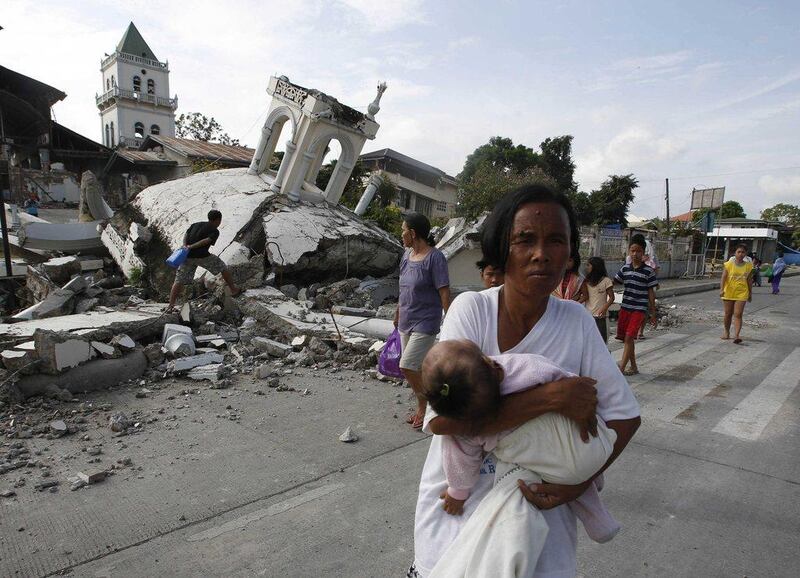LOON, Philippines // Rescue workers raced Wednesday to reach isolated communities on a popular Philippine tourist island that was devastated by a huge earthquake, as aftershocks tormented survivors and the death toll climbed to 144.
The 7.1-magnitude earthquake smashed the central island of Bohol on Tuesday morning, triggering landslides that engulfed entire homes, ripping apart bridges and tearing down centuries-old churches.
The national disaster agency said the number of people confirmed killed on Bohol and neighbouring islands had climbed from 93 to 144. Civil defence chief, Eduardo del Rosario said another 291 people are injured.
“Our efforts today are focused on reaching isolated areas. We suspect individuals are trapped out there and we have to conduct search and rescue,” National Disaster Risk Reduction and Management Council spokesman Reynaldo Balido said.
With destroyed bridges, ripped-open roads and power outages fragmenting the island of about one million people, Mr Balido said authorities were struggling to reach isolated communities and had no idea how bad the damage was in some areas.
“We don’t even have an estimate ... we are just assuming that since there were collapsed buildings, we must search for them,” he said, when asked how many people remained missing.
At Loon, a small coastal town of about 40,000 people just 20 kilometres from the epicentre of the earthquake, shocked survivors wandered around the rubble of collapsed buildings looking for relatives.
Serafin Megallen, a farmer, said he dug with his hands, brick-by-brick, to retrieve his mother-in-law and cousin from the rubble of their home.
“They were alive but they died of their injuries three hours later. There was no rescue that came, we had to rely on neighbours for help,” he said.
Mr Megallen said a neighbour with a lorry tried to drive the bodies to Loon’s funeral parlour, only to find out the bridge across a river on the way was destroyed.
The bodies were then taken across the river on a boat.
“But no one will give them last rites because the church was also destroyed,” he said.
Ten churches, many of them dating back centuries to Spanish colonial rule of the Philippines, were destroyed or badly damaged on Bohol and the neighbouring island of Cebu.
Loon’s limestone Our Lady of Light church was reduced to mounds of crushed rocks.
In front of the rubble an improvised altar had been erected with a lone statue of the Virgin Mary, where teary residents stopped by to make the sign of the cross.
“We’re trying our best to keep hopes up, but in this desperate situation there is nothing much we can do beyond giving comforting words,” local priest Father Tomas Balakayo said.
“I try to be strong but this is terrible, what have these people done to deserve this?”
Meanwhile, the only people involved in the search and rescue efforts on Wednesday morning at Loon were residents and local police, who themselves had lost their homes or relatives.
They struggled as aftershocks continued to rattle the area. More than 800 aftershocks had been recorded, including one on Wednesday morning with a magnitude of 5.1, according to national disaster authorities.
Most of the confirmed deaths were on Bohol, which is one of the most popular tourist islands in the Philippines because of its beautiful beaches, rolling Chocolate Hills and tarsiers.
Nine people died on neighbouring Cebu island, home to the Philippines’ second-biggest city of the same name.
The Philippines lies on the so-called Ring of Fire, a vast Pacific Ocean region where many of Earth’s earthquakes and volcanic eruptions occur.
The deadliest recorded natural disaster in the Philippines occurred in 1976, when a tsunami triggered by a 7.9-magnitude earthquake devastated the Moro Gulf on the southern island of Mindanao.
Between 5,000 and 8,000 people were killed, according to official estimates.





